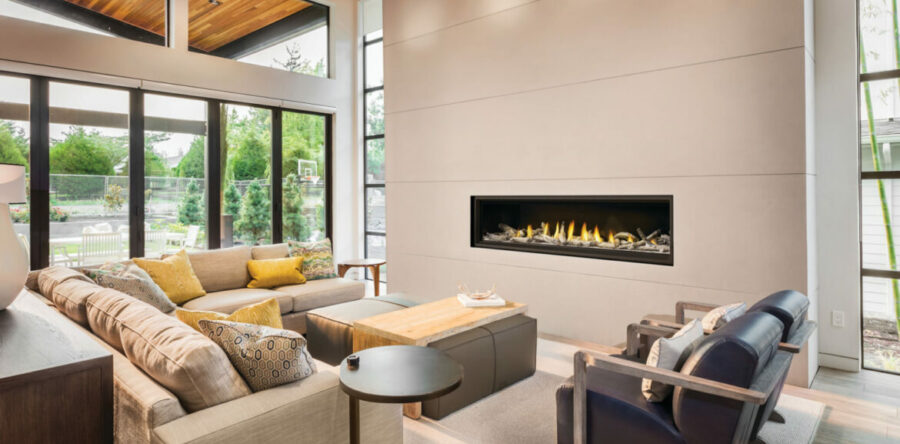We talked about soot and pilot lights in Part 1. Now, let’s continue our discussion with other topics relating to the enjoyment and performance of your gas fireplace, stove, or insert.
Your owner’s manual is full of valuable information. Please read it, file it, and know where to locate it. It will give you a better understanding of operating and maintaining your hearth appliance. We will refer to this at several points in this article.
GLASS CLEANING
When we talk about cleaning glass, we’re talking about cleaning the inside and the outside.
Caution: The glass gets very hot; therefore we should make every effort to keep hands away from it. When the fireplace is running, maintain a clear space of at least three feet from the front of the fireplace. Never clean hot glass. Always let it cool to room temperature.
Outside Glass: However, small, curious hands sometimes touch the glass when the fireplace is not operating. Fingerprints, mac & cheese, peanut butter, etc., have been known to get smeared on the outside of the glass.
Don’t operate the fireplace, stove, or insert if the outside of the glass is noticeably dirty. Clean the outside as needed.
Inside Glass: Small particles from combustion and soot will form inside the glass. The inside will need cleaning once or twice per year to remove this.
Do not use a window cleaner on the glass for your fireplace. Be sure to use a glass cleaner designed for gas fireplaces. The cleaner is a thin paste rubbed on and then polished with a clean, soft rag. Remove the glass according to the manufacturer’s directions and follow the bottle’s instructions for the gas fireplace glass cleaner.
Your WE LOVE FIRE dealer keeps a good supply on the counter.
Note: Never use a razor blade to scrape the glass because it could damage the thin protective coating.
NORMAL OPERATING SOUNDS
For the most part, your fireplace will operate quietly. However, you may notice some slight sounds, which are perfectly normal. In technical terms, we will refer to them as ‘click,’ ‘poofs,’ ‘whoosh,’ and ‘pops’! 🙂
You might hear a low, dull ‘click’ as the gas valve opens and closes. If you operate a fireplace in the Intermittent Pilot (IPI) mode, you’ll notice a ‘click, click, click’ as the pilot ignites. There may also be a low whisper-like noise as gas moves through the pilot or burner.
Fans are the noisiest component on a gas fireplace, insert or stove. The higher the fan speed, the more air moves through the fireplace. Think of it like the wind outside. It’s much noisier on a windy night vs. a quiet evening with little or no wind blowing. The more air the fan is moving, the louder it gets.
If you are burning LP gas, hearing an ‘extinction pop’ is not uncommon. This might occur when the LP unit shuts off. It can sound like a loud ‘poof.’
You might notice two other sounds: the lower grill’s remote receiver may ‘click’ when it receives a signal from the transmitter. And, some fireplaces may ‘pop’ as the steel heats and/or cools down.
FIREPLACE ODORS
There can be a few gas fireplace odors to be aware of. The one to be concerned with and needs immediate attention is natural gas or LP gas smell.
Caution: If you smell raw fuel with a gas appliance, you have a potentially hazardous situation. The gas smell has been added for good reasons. If you smell gas odors, call your gas supplier immediately.
If your fireplace, stove, or insert is new, paints and solvents used during manufacturing must cure and burn off during the first few fires. If possible, make the first few fires of 30–60 minutes on relatively mild days. Your fireplace may actually smoke a bit during the curing process.
Open a few windows for fresh air, as the odor and smoke may take a little time to dissipate.
After long periods of non-use, dust or pet hair may collect on hot fireplace surfaces. As these burn off, there may be an odor. Keeping the lower grill area clean will help prevent this from happening.
ACCENT LIGHT BULB REPLACEMENT
Accent lighting enhances the ember glow effects. If it is equipped with this feature, bulbs will eventually need to be replaced.
This procedure can vary from model to model. The owner’s manual will be your best resource if you plan to replace the bulbs yourself.
BATTERY REPLACEMENT
Fireplaces with remote controls and IPI systems use batteries. When these batteries get low, you may notice a small red light blinking and hear a sound chirping. The battery compartment might be challenging to find, especially on the remote-control receiving unit. Many are opened with a spring-loaded door. Others may use a slide or a clip for the battery compartment.
Keep the batteries in your IPI system fresh. If there is a power outage, you will still be able to use the fireplace.
FRONT & SCREEN REMOVAL
To clean the glass or do any service or maintenance work, you will need to remove the decorative front and/or protective screen (if equipped) from your fireplace, stove, or insert. Most fronts will hook, clip or slide to remove and re-install them. Your owner’s manual will explain the procedure for your specific model.
NEED OTHER INFORMATION OR HELP?
It’s worth mentioning again that it’s always a good idea to keep your appliance owner’s manual where you can quickly reference it when needed.
However, please be aware that your WE LOVE FIRE dealer is eager to help you enjoy your fireplace, stove, or insert. We are your best resource for equipment, service, and parts. We have experienced professionals available to repair and maintain your equipment and answer all of your questions. Count on us. We’re here when you need us!











2 Responses